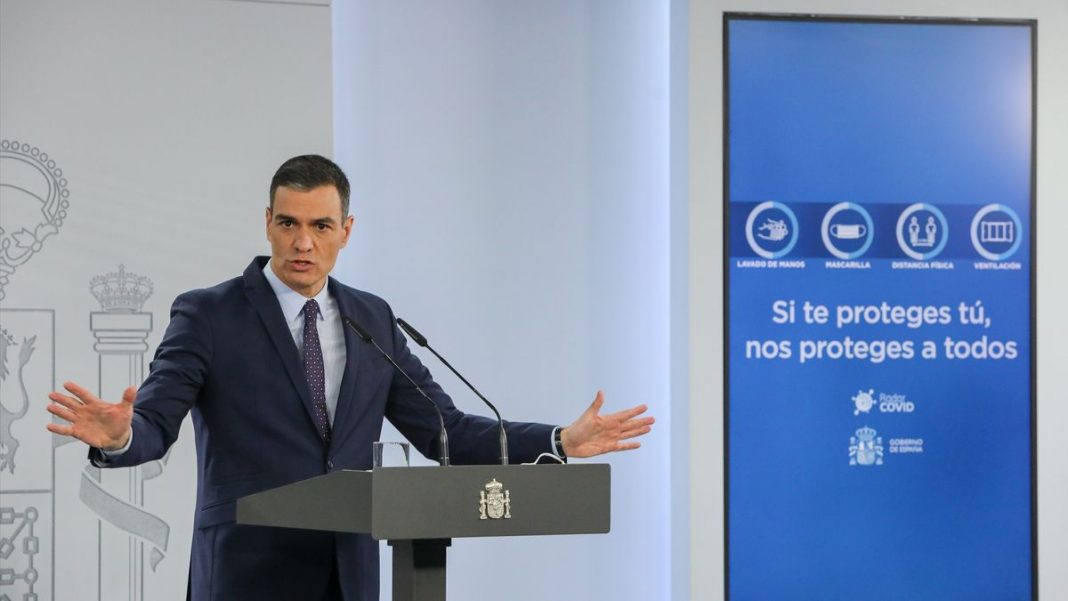This week, the Government will send the European Commission its Recovery, Transformation and Resilience Plan with the package of reforms and investments that Spain intends to promote in order to channel the 140 billion in European reconstruction funds that it will receive until 2026, along with the Stability Programme, with the deficit figures forecast for the coming years.
Both plans must be sent to Brussels before 30 April, so are expected to be approved by the Government at next Tuesday’s Council of Ministers, according to government sources speaking with Europa Press, which in principle rules out the holding of an Extraordinary Council of Ministers.
The President of the Government, Pedro Sánchez, appeared at a press conference a fortnight ago to detail the content of the provisional draft of the Recovery Plan, set out in four priority areas and composed of 212 measures, of which there are 110 investments and 102 reforms to channel the reconstruction funds to be received by Spain to deal with the crisis.
Among the fundamental objectives set by the government are the promotion of economic recovery in the short term and the restructure and transformation of the Spanish economy to make it more competitive and sustainable, the greatest opportunity Spain has had in a century to bring about a real transformation of its economy, in Sánchez’s own words.
Of the plan as a whole, 39% will be earmarked for ecological transition, 29% for digital transformation, 10.5% for education and training and 7% for R+D+i, according to the President.
Of the investments, 20 primary ones are envisaged for the next three years, with the focus on sustainable mobility, housing, energy, modernisation of public administration and digitalisation.
Controversial reforms
With regard to reforms, the most controversial part of the plan, the aim is to tackle the pension system, transform the labour market, the modernisation of the health system, reform of the electricity system, as well as the modernisation of the justice system, the new care economy, water law and tax reform.
In total, public investments of approximately 70,000 million euros will be deployed in the period 2021-2023, which will have an “immediate” impact on the economy and employment this year.
Specifically, the Government puts the positive effect of the European funds at 2% per year for both this year and next, and also considers that they will enable the creation of 800,000 new jobs in six years.
The government has expressed its confidence that the planned road map will be supported so that the Commission can approve the recovery plans in June. However, it is confident that Brussels will make EU regulations on state aid more flexible in order to speed up the projects.
While waiting for the funds to arrive, the government has already included channelling more than 27 billion euros into the General State Budget for 2021, to be financed with these funds and destined for the investments and reforms included in the Recovery, Transformation and Resilience Plan.
Deficit of around 8%
The Government will also send the Stability Programme to Brussels this week, which will include the medium-term fiscal scenario and the updated macroeconomic framework with the previously announced downward revision of forecasts for 2021 in view of the impact of the third wave of Covid-19 and the delay in European funds.
At the beginning of April, the second Vice-President of the government and Minister for Economic Affairs and Digital Transformation, Nadia Calviño, announced a cut of 3.3 percentage points in the GDP growth forecast for this year, to 6.5%, as a result of the slowdown in the economy in the first quarter, although the estimate for 2022 was raised to 7%.
These forecasts are a far cry from those presented to Brussels in October, which indicated an increase of 9.8% including European funds or 7.2% without taking these into account. On this occasion, the government has opted to present a single forecast, an increase of 6.5%, which already takes into account the impact of the Recovery Plan to be presented in order to access the funds.
Moreover, in October, after the presentation of the General State Budget, the Executive calculated that the deficit would close this year at 7.7% of GDP, after closing 2020 at 10.97% including Sareb, with a public debt of 117.4% of GDP. However, the government has already announced that this year’s deficit figure will be revised and is likely to worsen, possibly exceeding 8%, given the cut in GDP growth.
The European Commission gave the green light for the suspension of fiscal rules for 2020 and 2021, an option adopted by Spain given the impact of the crisis. This implies the suspension of stability targets for those two years, which have been replaced by reference rates.
Looking towards 2022, the Finance Minister and government spokesperson, María Jesús Montero, has reiterated her confidence that Brussels will also maintain the suspension of fiscal rules for next year in order to be able to continue revitalising the economy without resorting to adjustment policies that would reduce consumption and public investment, a decision that the Eurogroup has pledged to make before the end of June.

